Looking for some new food ideas for your next backpacking trip? Here are ten of my favorite high-calorie, lightweight backpacking meal recipes. Each meal includes an entree, hot drink and dessert, provides at least 1,000 calories, takes less than 15 minutes to prepare, and most of the ingredients can be found in regular grocery stores. They are inexpensive (around $5 each) and I think they taste pretty darn good. Give em a try and let me know what you think.
Monster Mac & Cheese
Calories: 1660, Dry Weight: 16.2 oz (103 cals/oz), Protein: 73g, Carbs: 225g, Fat: 52g
Mac & Cheese Entree (12 oz, 1140 cal), Hot Cocoa (1.2 oz, 145 cal), Cookies (3 oz, 375 cal)
This is the granddaddy of hungry thru-hiker meals. It’s cheap, easy to cook, packed full of calories and you can find most of the fixins in convenience stores and gas stations wherever you travel. This is my go-to meal after a long day on the trail when I’m craving comfort food.
Ingredients:
1 box Kraft Macaroni & Cheese
2.6 oz Foil Pouch Tuna (or other shelf-stable meat product)
1 Cheese Stick (cubed)
1 tbsp Whole Milk Powder
1 tbsp Grated Parmesan
1 tbsp Olive Oil
Seasoning: Black Pepper, Onion Powder, Italian Seasoning (optional)
Water: 3 cups (24 fl oz)
Hot Drink: 1 pk Hot Cocoa Mix
Dessert: 2 Grandma’s Cookies
Directions:
Bring 3 cups water to boil in pot. Pour 1 cup hot water into mug for cocoa, then return pot to flame. Add macaroni and cook for 5 minutes, stirring occasionally. Cover pot with lid and transfer to cozy for 5 minutes, or until noodles are cooked and water is mostly absorbed. Add olive oil, cheese, cheese powder, milk powder, tuna and a splash of water and stir to mix. Season with pepper, onion powder and Italian seasoning. Top with grated Parmesan.
Parmesan Chicken Couscous
Calories: 1260, Dry Weight: 13.6 oz (92 cals/oz), Protein: 50g, Carbs: 182g, Fat: 37g
Couscous Entree (9.9 oz, 870 cal), Coffee w/ Creamer (0.5 oz, 60 cal), Cupcakes (3.2 oz, 330 cal)
This is one of the quickest and easiest backpacking meals to make. Couscous requires no simmering, just add boiling water and let it sit for a few minutes in your pot cozy. I make this meal whenever I’m tired and hungry, don’t feel like cooking and need food in the belly ASAP.
Ingredients:
1 box Near East Couscous (Herbed Chicken)
1/2 pouch (3.5 oz) Foil Pouch Chicken (or Tuna)
1 tbsp Grated Parmesan
1 tbsp Olive Oil
Water: 2 1/4 cups (18 fl oz)
Hot Drink: 1 pk Instant Coffee w/ 4 tsp Powdered Creamer
Dessert: 2 Hostess Cupcakes
Directions:
Bring 2 1/4 cups water to boil in pot. Pour 1 cup hot water into mug for coffee, then transfer pot to cozy. Add olive oil, seasoning packet, couscous and chicken. Stir briefly, cover pot with lid and let sit for 3-5 minutes, or until water is absorbed. Fluff with spoon and top with Parmesan.
Cheesy Bacon Mashed Potatoes
Calories: 1250, Dry Weight: 9.5 oz (132 cals/oz), Protein: 35g, Carbs: 130g, Fat: 65g
Mashed Potato Entree (6.2 oz, 750 cal), Tea w/ Creamer (0.5 oz, 60 cal), Peanut Butter Cups (2.8 oz, 440 cal)
Here’s another quickie that requires very little cooking time. It’s also one of the lightest and most calorie-dense meals I make (132 calories per ounce of dry weight.) These cheesy, baconey, gooey mashed potatoes give new meaning to the term “food that sticks to the ribs.”
Ingredients:
1 pouch Idahoan Mashed Potatoes (Loaded Baked)
1 oz Real Bacon Bits
1 Cheese Stick (cubed)
1 tbsp Olive Oil
Seasoning: Dried Chives (optional)
Water: 3 cups (24 oz)
Hot Drink: 1 bag Chai Tea w/ 4 tsp Powdered Creamer
Dessert: 2 King-Size Reese’s Peanut Butter Cups
Directions:
Bring 3 cups water to boil in pot. Pour 1 cup hot water into mug for tea, then transfer pot to cozy. Add olive oil, potatoes, bacon and cheese. Stir until combined, cover pot with lid and let sit for 1-3 minutes, or until water is absorbed. Fluff with spoon and top with dried chives.
Homestyle Turkey Dinner
Calories: 1420, Dry Weight: 15.7 oz (90 cals/oz), Protein: 48g, Carbs: 223g, Fat: 37g
Turkey Dinner Entree (11 oz, 935 cal), Apple Cider (0.7 oz, 80 cal), Cherry Pie (4 oz, 405 cal)
This meal reminds of Thanksgiving or Christmas dinner. Sometimes, after a long, lonely day on the trail when I’m feeling a bit homesick, I’ll make this and it always cheers me right up. Something about the familiar tastes of the holiday season soothes my soul (and my stomach.)
Ingredients:
1 box Kraft Stovetop Stuffing
1/2 pouch (3.5 oz) Foil Pouch Chicken
1 tbsp each: Harmony House Dried Onions, Celery & Carrots
1 oz Dried Cranberries
1 tbsp Olive Oil
Water: 2 1/2 cups (20 oz)
Hot Drink: 1 pk Spiced Hot Apple Cider Mix
Dessert: 1 Cherry Snack Pie
Directions:
Bring 2 1/2 cups water to boil in pot. Pour 1 cup hot water into mug for cider, then return pot to flame. Add olive oil, onions, celery, carrots and cranberries and simmer for 3-5 minutes. Add stuffing, stir carefully to combine (pot will be very full), then add chicken. Cover pot with lid and transfer to cozy for 5 minutes, or until all water is absorbed. Fluff with spoon before eating.
Chicken Pasta Primavera
Calories: 1250, Dry Weight: 12 oz (104 cals/oz), Protein: 47g, Carbs: 152g, Fat: 51g
Pasta Primavera Entree (8.9 oz, 790 cal), Tea w/ Creamer (0.5 oz, 60 cal), Chocolate Bar (2.6 oz, 400 cal)
My favorite pre-packaged backpacking meal is Mountain House Pasta Primavera. Unfortunately, freeze-dried meals are expensive, don’t have that many calories and are not sold in most grocery stores. So, I decided to try and make my own budget-friendly version.
Ingredients:
1 pouch Knorr Italian Sides (Creamy Garlic Shells)
1/2 pouch (3.5 oz) Foil Pouch Chicken (or Tuna)
1 tbsp each: Harmony House Dried Broccoli, Carrots, Bell Peppers & Leeks
1 tbsp Whole Milk Powder
1 tbsp Grated Parmesan
1 tbsp Olive Oil
Seasoning: Black Pepper, Dried Parsley (optional)
Water: 2 3/4 cups (22 oz)
Hot Drink: 2 bags Black Tea w/ 4 tsp Powdered Creamer
Dessert: 1 King Size Hershey’s Chocolate Bar
Directions:
Bring 2 3/4 cups water to boil in pot. Pour 1 cup hot water into mug for tea, then return pot to flame. Add milk powder, olive oil, dried veggies, pasta and seasoning mix and boil gently for 5 minutes, stirring occasionally. Add chicken, cover pot with lid and transfer to cozy for 5 more minutes, or until noodles are cooked and sauce has thickened. Season with pepper, parsley and top with grated Parmesan.
Bacon & Egg Scramble
Calories: 1315, Dry Weight: 9.8 oz (134 cals/oz), Protein: 57g, Carbs: 78g, Fat: 86g
Bacon & Eggs Entree (4.5 oz, 725 cal), Coffee w/ Creamer (0.5 oz, 60 cal), Honey Bun (4.8 oz, 530 cal)
I love eggs, but I could never find a good way to make them on the trail …until now. The secret is Ova Easy Egg Crystals. Unlike other powdered eggs I’ve tried, these cook and taste like real eggs! They’re a bit pricey, but it’s worth it not to have to eat oatmeal every morning.
Ingredients:
1/2 pkg (2.25 oz) OvaEasy Egg Crystals (equivalent to 6 eggs)
1 oz Real Bacon Bits
1 tbsp each: Harmony House Dried Onions, Leeks & Bell Peppers
1 Cheese Stick (cubed)
1 tbsp Olive Oil
Seasoning: Salt, Black Pepper, Dried Thyme (optional)
Water: 2 1/8 cups (17 oz)
Hot Drink: 1 pk Instant Coffee w/ 4 tsp Powdered Creamer
Dessert: 1 Jumbo Honey Bun
Directions:
In a quart-sized Ziploc baggy, mix: egg crystals, dried veggies, seasonings and 1 1/8 cup water. Set aside for 5 minutes so veggies can re-hydrate. Bring remaining 1 cup water to boil and pour into mug for coffee. Return pot to flame over very low heat, add olive oil and then scramble egg mixture, stirring frequently so they don’t stick. When eggs are nearly set up, mix in bacon and cheese, remove from heat and cover for 1-2 minutes until cheese is all melted.
Apple Pecan Loaded Oatmeal
Calories: 1475, Dry Weight: 11.3 oz (130 cals/oz), Protein: 26g, Carbs: 221g, Fat: 54g
Oatmeal Entree (7.1 oz, 990 cal), Coffee w/ Creamer (0.5 oz, 60 cal), Donuts (3.7 oz, 425 cal)
This is the perfect breakfast for when you have to climb a huge mountain before lunch. It’s hot, sweet and packed full of carbs for all-day energy. I’m not a fan of the goopey texture of oatmeal myself, so I like to chunkify mine with granola, nuts and dried fruit (adds calories too.)
Ingredients:
2 packs Quaker Maple & Brown Sugar Oatmeal
1/2 cup Nature Valley Protein Granola
1 tbsp Whole Milk Powder
1 oz Raisins (or Dried Cranberries)
1 oz Dried Apples
1 oz Chopped Pecans
Seasoning: Cinnamon (optional)
Water: 2 1/2 cups (20 oz)
Hot Drink: 1 pk Instant Coffee w/ 4 tsp Powdered Creamer
Dessert: 6 Mini Donuts
Directions:
Bring 2 1/2 cups water to boil in pot. Pour 1 cup hot water into mug for coffee, then return pot to flame. Add milk powder, dried fruit, nuts, oatmeal and granola and simmer for 3-5 minutes, or until it reaches the consistency you like. Top with a dash of cinnamon. Allow to cool for a few minutes before eating because this stays hot for a long time. Try not to burn your tongue.
Hearty Split Pea Soup
Calories: 1110, Dry Weight: 9.3 oz (119 cals/oz), Protein: 29g, Carbs: 146g, Fat: 46g
Pea Soup Entree (5.1 oz, 610 cal), Hot Cocoa (1.2 oz, 145 cal), Candy(3 oz, 355 cal)
This is one of those foods I hated as a child, but love as an adult. If you haven’t tried split pea soup in a while, I encourage you to give it another shot. Sure, it looks green and slimy, but if you can get past that, it tastes great. I like to eat this after a long hike on a crisp Fall evening.
Ingredients:
1/4 pouch (2.1 oz) Bear Creek Split Pea Soup Mix
1/4 cup (1.2 oz) Harmony House Hamish Bits
1 tbsp each: Harmony House Dried Onions, Carrots, Celery
1/4 cup (1 oz) Croutons
1 tbsp Grated Parmesan
1 tbsp Olive Oil
Water: 3 cups (24 oz)
Hot Drink: 1 pk Hot Cocoa Mix
Dessert: 1 bag Chocolate Blueberry Candy
Directions:
Bring 3 cups water to boil in pot. Pour 1 cup hot water into mug for cocoa, then return pot to flame. Add olive oil, dried veggies and ham bits, then slowly stir in split pea soup mix. Simmer for 5 minutes, stirring occasionally. Cover pot with lid and transfer to cozy for 5 more minutes, or until peas are fully cooked. Top with croutons and grated Parmesan.
Darn Good Trail Chili
Calories: 1010, Dry Weight: 8.3 oz (122 cals/oz), Protein: 45g, Carbs: 110g, Fat: 43g
Chili Entree (5.8 oz, 660 cal), Coffee w/ Creamer (0.5 oz, 60 cal), Snack Mix (2 oz, 290 cal)
After a long dusty day on the trail, nothing warms you up like a like a bowl of hot chili. Fair warning: This is best eaten when solo camping, if you don’t want to risk the wrath of your tent-mates later. Flatulence aside, chili is an excellent trail food for cowpokes and trailpokes.
Ingredients:
1/3 pouch (3.3 oz) Bear Creek Darn Good Chili Mix
1/4 cup (1 oz) Harmony House Beefish Bits
1 tbsp each: Harmony House Dried Onions, Diced Tomatoes, Tomato Powder
1 Cheese Stick (cubed)
1 tbsp Olive Oil
Seasoning: Salt, Black Pepper, Parsley (optional)
Water: 3 cups (24 oz)
Hot Drink: 1 pk Instant Coffee w/ 4 tsp Powdered Creamer
Dessert: 1 pack Reese’s Snack Mix
Directions:
Bring 3 cups water to boil in pot. Pour 1 cup hot water into mug for coffee, then return pot to flame. Add olive oil, dried veggies, tomato powder, beef bits and chili mix. Simmer for 5 minutes, stirring occasionally. Cover pot with lid and transfer to cozy for 5 more minutes, or until beans are fully cooked. Top with cheese and season with salt, pepper and parsley.
Spicy Southwest Taco Rice
Calories: 1510, Dry Weight: 13.8 oz (110 cals/oz), Protein: 44g, Carbs: 244g, Fat: 40g
Rice Entree (8.6 oz, 940 cal), Hot Cocoa (1.2 oz, 145 cal), Fig Newtons (4 oz, 425 cal)
Here’s another southwestern favorite of mine. Tender rice and crispy tortilla strips provide a variety of textures and the taco seasoning, veggies and hot sauce give it a boost of flavor. This is the opposite of bland trail food. If it didn’t have so many calories, I’d even eat this at home.
Ingredients:
1 pouch Knorr Fiesta Sides (Taco Rice)
1/4 cup (1.2 oz) Harmony House Taco Bits
1 tbsp each: Harmony House Dried Onion, Corn, Bell Pepper, Diced Tomato
1 Cheese Stick (cubed)
1/2 oz Tortilla Strips
1 tbsp Olive Oil
Seasoning: Dried Cilantro, Hot Sauce (optional)
Water: 3 cups (24 oz)
Hot Drink: 1 pk Hot Cocoa Mix w/ Chili Powder & Cinnamon (optional)
Dessert: 4 Fig Newtons
Directions:
Bring 3 cups water to boil in pot. Pour 1 cup hot water into mug for cocoa, then return pot to flame. Add olive oil, dried veggies, taco bits and rice mixture. Cover and simmer on low heat for 5 minutes. Stir, then transfer pot to cozy for 5 more minutes, or until rice is tender and water is absorbed. Season with dried cilantro and hot sauce and top with tortilla strips and cheese.


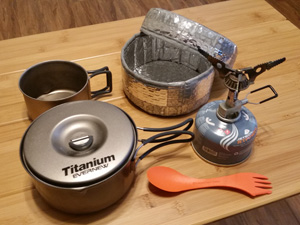
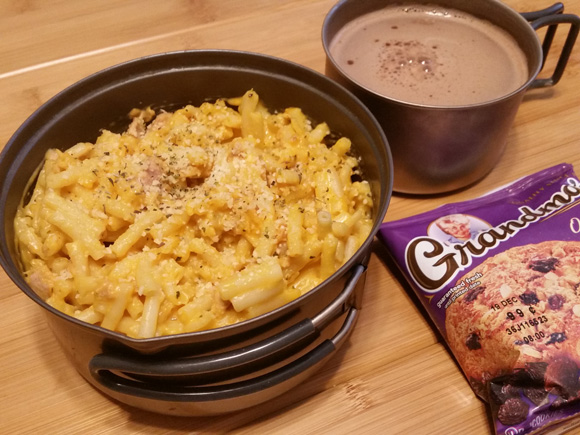
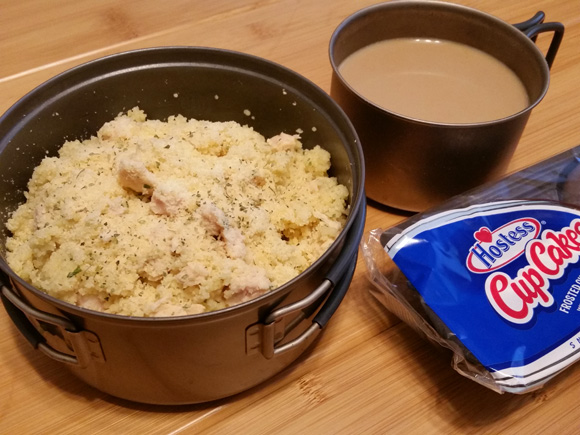

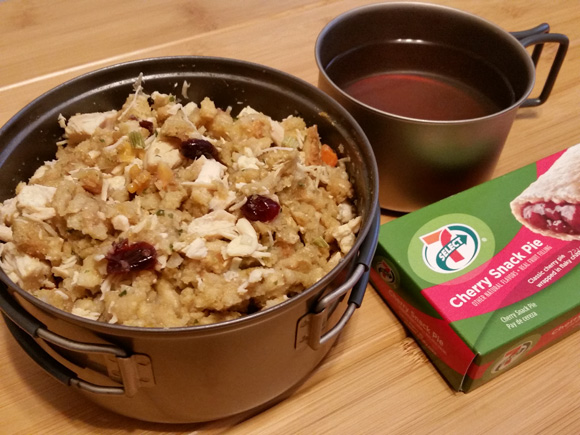


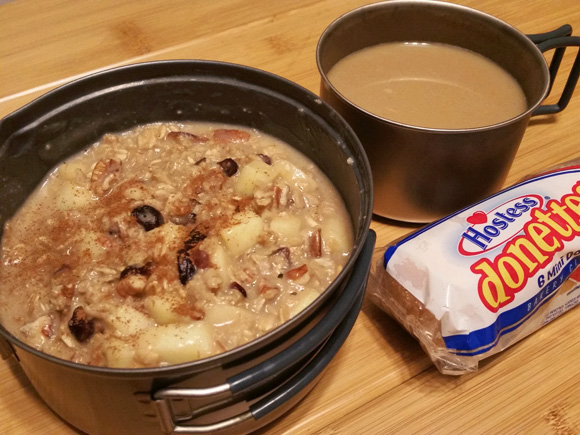
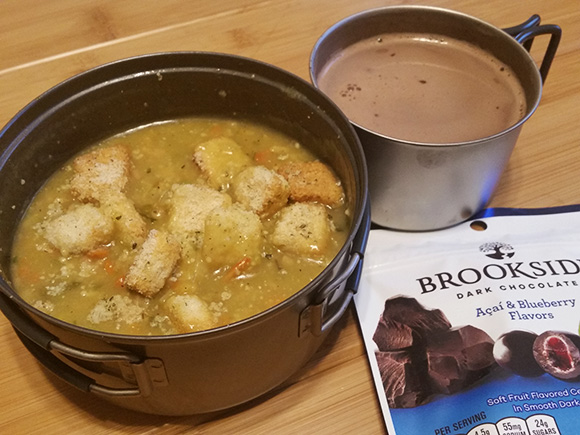
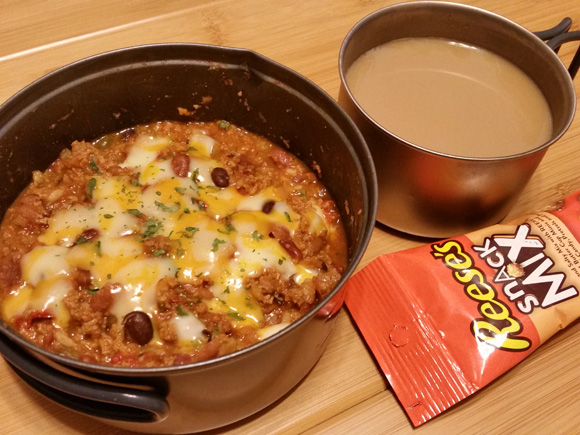

 My name is Erik Asorson, aka "Erik the Black." I'm a long-distance backpacker, cartographer and author of
My name is Erik Asorson, aka "Erik the Black." I'm a long-distance backpacker, cartographer and author of 

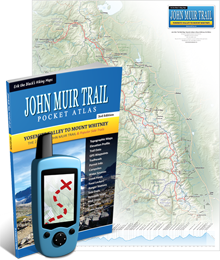
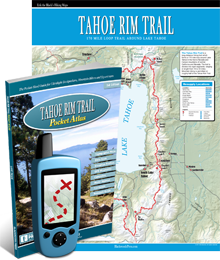
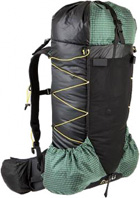
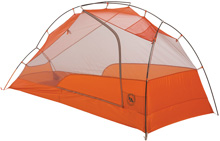
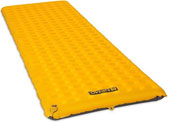
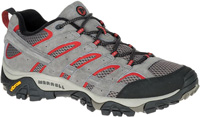

Hi Erik,
I notice that in a lot of your recipes you use half of a 7 oz chicken pouch. What do you do with the other half? Does it keep if you use the second half the next day?
Kevin: Good news! I recently found that Walmart now sells chicken in 2.6 ounce pouches which are perfect for a single serving. In the past I would put the other half of the large pouch in a ziploc and eat it later. But it doesn’t last very long and starts to get green pretty quick. Usually it wouldn’t last until dinnertime the next day, so I would end up eating it the next morning.
Such a basic question… In many of your recipes one of the ingredients is a cheese stick. Can you give me an example of a cheese stick?
Kevin: Cheese sticks are the 1 ounce sticks of cheese that you can get at the grocery store. The most popular is mozzarella “string cheese,” but they also have cheddar and other types. Since they are individually wrapped in plastic they tend to last longer on the trail than regular bricks of cheese that get exposed to air as soon as you unwrap them.
Great ideas and one thing that tarts up Mac and cheese is red Chile flakes. Lately my backpacking food is more John Muir like. I take a few loaves of good bread pain levain, cheese, salami, soup mix, tea, and oatmeal with dried fruit. Some sugar for the tea and maybe some dried apples for desert. That’s it, Simple and easy. Not that heavy either.
Erik,
I went vegan almost a year ago and at first it seemed difficult for regular meals much less backpacking but ots gotten a lot easier. One amazing item ive discovered in the process is Nutritional Yeast. Its a dry flake, super lightweight, and adds flavor, lots of nutrition, all your B vitamins, and 8g of protein per 1.5 tablespoon. This is like a secret in the vegan community but a godsend to my backpacking life. I add to every rice, pasta, potatoe based one pot meal. Something maybe youd like to check out. Side note: a friend just mentioned your blog and i was happy to hear your still around, you were the first blogger, gear reviewer i stumbled on when I got into the sport? activity? About 8 years ago. Thanks for setting me off straight!
I may be really late to this party, but since I couldn’t find a time stamp to know how old this post is, I’m going to go ahead and comment.
I’m surprised at those whom are commenting that they can’t eat all of a certain food at a meal and don’t know what to do. Well, if it was me, I’d simply eat it for breakfast or the next meal. That way, it won’t go to waste, but you don’t have to stuff yourself or toss it. And the next meal is quicker to fix as all you’ll need to do is reheat it. (And simply cover it and set it in your bear bag with the other food – stabilized so it doesn’t spill – use a bit of paracord if you need to). Then, eat the next scheduled meal whenever you want it.
The pioneers used to put their beans on to soak at night, and then in the morning, before they broke camp, they would bring the pot to a boil, wrap it up and hook it under the wagon to cook away. You can do the same thing with a cozy and your next meal. Bring to a boil, put in cozy and wrap it up. By the time you’re ready for it, it will be done. Try it at home and see how it works and if you like the texture. hth
Erik,
I just down loaded these meal reciepes. Thanks for sharing. Just a brief look, it appears that the Knorr envelope based meals pack a lot of calories; then I see that they are typically two servings. I’m going to try these at home first because I don’t think I can eat that much in one meal at 69 years young.
I’m looking forward to a more varied diet this upcoming hiking season.
The Knorr envelopes are easy to portion into two ziploc baggies if you can’t eat an entire package. I do that for my son and I when we backpack. You can cook them right in the baggie also for easy cleanup.
These look appetizing and interesting! Different from what I’ve seen elsewhere, and I appreciated the nutrient breakdowns and drink and snack suggestions – it was nice to see it all in one place. Also appreciated Derek’s keto comments, as I’m hiking with a type 1 diabetic, and eating low carb is much easier with insulin for him.
As far as the pile of comments about veg and vegan foods…um, this site doesn’t seem to be about that, although I am sure there are sites that ARE. I don’t eat gluten (unfortunately) but many of these meals could have easy GF substitutions (GF stuffing mix, potatoes, and Knorr Selects rice sides all come to mind).
Thanks for a really nice site. 🙂
Do you enjoy wax covered cheese like Babybel Cheese?
How many days would you carry them?
@AJ: I don’t eat those cheeses personally, but I have seen other hikers carrying them. If I’m not mistaken, they are pretty shelf-stable, so I imagine they would last for five days or maybe more.
Erik,
Thank you very much for your website and blog, I have learned a ton from you. I just purchased a 900ml cooking pot with the fold out handles similar to yours. I noticed that your cozy does not leave an opening in the side for the handles, do you have any issues dropping the hot pot inside the cozy without using the handles? I was pondering leaving a gap for the handles to extend out and then wrap around the outside of the cozy.
Thank you,
Kevin
@Kevin: It takes a little practice getting the handles folded up and the pot inside without burning your hands, but once you get the hang of it it’s easy. I grip the folded handles on the rubber part using one hand and lower the pot into the cozy. I would advise against cutting holes for the handles because it will make an opening for heat to escape and make the cozy less efficient.
Just a suggestion: I fold up the handles of my pot, set it on the ground, then slip the bottom of the cozy over the top of the pot. Then I can pick it up and set it into the top of the cozy. It’s upside down, but it works.
Thank you so much for the information. I love to cook, and I’m hoping to get out of the kitchen and onto the trail.
ah erik, bless your heart. your advice on food and in general has transformed my hiking. i recently did a six night/ seven day and your recipes were the envy of the bag eaters! i gave you full credit of course. so a couple of things… why have you modified the cooking/cozy time for your mac and cheese? the previous boil two, cozy ten is perfect. and second, in reply to my fellow canadian, there has been nothing available in foil bags here in canada. probably due to some obscure health reg. having said that, i was in walmart the other day and stumbled across hereford corned beef in a pouch. that would be excellent with instant mashed. also erik, you might find intriguing, i am a devotee of intermittent fasting. and this time i took it on the trail. one meal a day, supper. and one small snack, either a bar, or a cereal/powdered milk/dehydrated berry mix. powdered full fat milk is also not available here in the north. for the six/seven i took 7.3lbs of food total. i made the concession of having a large pack of tuna or chicken- travelled across the border to buy it -or the equivalent weight in salami as my protein with the carbohydrate matrix. and i took alpineaire dehydrated peas and carrots for vegetables and mixed them in. again, you are my guru, and i thank you…
@Gebert: Thanks, glad you liked em. With pasta I find that it turns out a little less mushy when you increase the boil time and decrease the cozy time, but you can do it either way. Especially if you need to conserve fuel, a minute or two of boiling and 10 minutes in the cozy works wonders. Happy trails.
I am always looking for new light weight recipes and these definitely hit the mark. I can’t wait to try them out and experiment. Thanks!
Eric’s point re running out of glycogen is spot on. Twice on the JMT I suddenly ran out of energy in the afternoon on uphill sections. Only solution is some carbs. We took minimum food – about 2lbs per day. I lost 22 lbs in 17 days. We did cut it a bit fine but it was reasoned decision.
I bought a Food Dehydrator years ago. I bought a FoodSaver to vacuum seal dried foods. I wanted to make custom MREs. I found an Impulse Sealer with extra heating elements on Amazon and poly tube on Uline. Later by chance I worked at Aline a company that makes high-end vacuum sealers that add a food grade nitrogen flush to the process. Did you know the GI MREs are nitrogen filled poly bags? I’ve experimented with dehydrating canned soups, beans, refried beans, tomatoes, tomato paste, etc. I’ve even tried vacuum packing stuff for resupply or to keep in trunk of my car.
I just discovered your site thru a friend of mine. I wish it had been sooner, i would have hiked all over Big Bear by now.. Great site and advice, thanks!!
Hey just came across a link to your site these are really awesome light weight meals, I am assuming you are american because in canada we don’t have the same commercial products ie pouch chicken, or as many flavoured instant grain and pasta options. But your recipes give me enough of an idea what I can do with what I got here.
I might try dyhydrating some cooked chicken breast meat …for a 3 week camp hike. DO you ever dyhydrate your own meat?
thanks,
Lisa
I love the StoveTop Stuffing idea, never thought of that.
I notice you mix a lot of instant things together which is what I did after finally divorcing expensive freece dried MH.
Last year I started dehydrating my own meals for my 3-6 day trips. Had I known how simple it is to dehydrate and how much easier it is to simply cook my own meals at home just the way I like it, and then have them in little sandwich bags, I’d have started long ago.
My favorite: Make a whole bunch of ground beef, onions, red kidney beans and some sloppy joe sauce, rehydrate in the mountains and in a separate container rehydrate some instant garlic mashed potatos. Combine. Unbelievable!
I’m from Canada and for the life of me I can’t seem to find “foil pouch Chicken” anywhere. Have checked, Safeway, Save-On, Sobeys, Superstore, IGA, Walmart. These chicken recipes look great and I am keen to try them on some upcoming backpack trips but I may have to dehydrate chicken instead.
Any suggestions anybody ?
@Chris: If you can’t find it in your local grocery stores you can buy the foil-pouch chicken online. It’s available here from Amazon.com. You could also substitute freeze-dried chicken or turkey, which has a longer shelf-life once opened. Or you could use foil-pouch tuna instead of the chicken. The tuna will probably be easier to find in your local grocery stores.
Thanks Erik. I already found the foil pack Tuna and I ordered a number of pouches of freeze dried chicken from Harvest Foodworks up here in Canada.
Thanks again ! Love your recipes !
You need to come east (Smokey Mtns) and hike! I really enjoy all the information that you share!! Great reads and great information…
Hi Eric, I have browsed countless websites looking for easy and tasty menu ideas for the trail and yours tops them all ! Awesome !
Thanks Erik, The whole 7 oz with the pasta is too much for one night for just little ol’ me! I think I’ll end up going with the freeze dried too. Thanks so much. 😉
Hi Erik,
I have a question about the foil chicken packets. When hiking alone 7 oz of chicken isn’t really suitable weight for one meal, how do you manage to keep the contents from spoiling after it has been opened? Thanks
@Stephanie: I usually eat the entire packet in a single serving (adding it to something like couscous or mac and cheese). I’ve tried eating only half and storing the rest in a ziploc baggy until the next evening. I didn’t get sick, but the chicken did look a little green and greasy after that, so I don’t really trust it. Now I always eat the whole thing as soon as it’s opened. Lately I’ve been using Freeze Dried Chicken and Turkey in place of the foil-pouch chicken because it’s lighter weight and has a longer shelf life.
Hi Erik
Of the five meals for dinner can you make these from a bag and a cozy?
We will be in the Grand Canyon in the spring and water will be short in one overnight stay. So trying not to have to clean the pot.
Really like your website. Has helped me a lot.
Thanks
Randy
@Randy: Couscous, Mashed Potatoes and Stuffing (#1,3 and 4) can all be made in a bag/cozy just by adding boiling water. The main ingredients require very little cooking so it works great. The noodle dishes (#2 and #5) will have a better texture if you boil and simmer them in a pan for a few minutes. Just adding boiling water to noodles tends to make them mushy.
Eric, valuable information here and very useful. Important question – after opening packs of meats (summer sausage, peperoni, etc.) how long does it last before spoiling.
Thanks Eric
@Howard: I have found that cured meats (like salami, pepperoni, cooked bacon, summer sausage) will last the entire five days until my next resupply. I don’t think the foil-pack meat or tuna will last as long because it’s not preserved in the same way, so I eat those within 24 hours of opening (usually right away).
Merry Christmas to all and Erik I simply loved the ideas and recipes. Looking forward for such ideas more. 🙂
so how are people dehydrating the beans and quinola? regular ovens? dehydrators? microwaves? for how long?
@Jac McMahon: One option is to buy Pre-dehydrated Beans and Vegetables from Harmony House. That way you can avoid the trail-and-error process of dehydrating them yourself.
Erik,
How long do you carry string cheese? Will it go bad or does the packaging prevent that?
@RobW: I carry string cheese up to five days with no problems. The air-tight packaging and low moisture content of mozzarella gives it a pretty long shelf life.
may i also suggest adjusting and substituting trail food to align with blood type? type A= mostly veggies, B= no chicken, AB= a mix, O= meet. Cook Right For Your Blood Type by Dr. Peter J. D’Adamo is a book with great info for the individual. what works well for one type, may not work for others. also has a ton of recipes! HYOH
Thank you for the recipes! My husband forwarded your link after a Cub Scout camping trip where we tried out some MRE’s and had a car camping version of one of my favorite backpacking meals. We’re on the hunt for a happy medium between lugging tons of stuff for car camping, and getting back in the groove for some backpacking.
Regarding beans on the trail, if you don’t have a dehydrator, Fantastic Foods has instant black beans and refried beans that used to be a staple for me. I couldn’t find them recently in my local store, but they used to be very near the Near East couscous mentioned in your first meal. Black beans + misc spices + instant rice + optional chicken in foil packet or can + optional cheese packet from Mac&Cheese (if using throw in some instant milk and squeeze margarine) + optional packet of piquante sauce + optional chip crumbles (Fritos seemed to last better) – yum.
I used to backpack with a college group – mainly young guys with sky high metabolisms . Squeeze margin was their friend and added in copious quantities to any meal to up the calorie count. In our backpacking meal class instant rice, instant potatoes, noodles from Ramen noodles, and Stove Top Stuffing were the basis for many meals. Instant beans, foil or canned meats, cheese packets from Mac&Cheese, and pre-grated canned Parmesan were the next step. Additional add ins included instant milk, squeeze margarine (your olive oil sounds better), nuts and seeds, dried fruit, dried veggies from anything – often instant soup, and misc spices such as granulated garlic, onion powder, ground cumin, ground coriander, dried oregano, and dried basil. Put the combination in a freezer zip lock, and add hot water on the trail.
I’m a lightweight camper and found a vacuum sealer to be essential for preparing my own foods – less packaging, really lightweight and easy to separate each meal per day AND I’m a strict vegan and make all my meals from scratch, only buying prepackaged vegan “granola” foodbars. I figured I’d post because I read a few comments about vegetarian options. I usually use dehydrated beans since they only require 10 minutes to prepare on the trail.
I’m going to dolly sods for 3 days and here’s my food list. I buy most of this from the bulk section of the grocery and the bread from the bakery for a high option with nuts baked into it, so the dinners are less than ~$6 each to prepare and high in nutrition. Using the vacuum sealer on the peanut butter sandwiches is crazy, they get squished down to a really thin sheet.
Fri.
Lunch: 2 peanut butter sandwich with seed bread; 3 foodbars
Dinner: quinoa/tofu/mushrooms/dried chives/chopped spinach/oliveoil/spices; hot tea
Sat.
Breakfast: coffee; steelcut oatmeal/nuts/berries
Lunch: 2 peanut butter sandwich with seed bread; 3 foodbars
Dinner: rice/tofu/beans/oliveoil/spices; hot tea
Sun.
Breakfast: coffee; steelcut oatmeal/nuts/berries
Lunch: 2 peanut butter sandwich with seed bread; 3 foodbars
These are a must for when we go hiking:
-Bagels (squished down to save room, still tastes the same) dipped in peanut butter with granola sprinkled on top.
-If you go to harmonyhousefoods.com they have a backpacking kit that includes several varieties of dehydrated veggies. Comes with soup recipes that you can make and put in a ziplock baggie. Add chicken or beef granules and whatever spices you want. All you do is add the dried contents to a cup of water, put over the fire and wait until everything’s rehydrated again. Goes great with any meal. Very lightweight.
-Peanut butter and brownies. This is probably the most important thing when we’re on the trail. Usually an afternoon snack when energy is low (and sometimes morale).
I am a parent and gs leader. These recipes are GREAT for families and groups with kids. Thank you!
My favorite lightweight backcountry dinner is the cheddar and broccoli rice side that Knorr/Lipton makes, plus a pack of chicken or tuna. One of those food that I would never eat in civilization, but I work on a trail crew so when I’ve packed 5-10 miles, clearing trees as I go, it tastes so goooooood. And it contains something green, which is a plus when you spend most of the summer eating things that are easy to transport by backpack or mule(fresh veggies don’t usually make it).
Hi Erik, three of your recipes went into my favourites even before I’ve tasted them. I realised I had become stuck with the tried favourites, like tinned reindeer stew (comes with the fat required for the pan) with champ (fresh leeks keeps forever; a quarter is enough). A QUESTION though: what is the minimum size of cookpot for these, to allow for the dried ingredient expansion. My 0.8 liter must be too small?
…And allow me to sneak in a question about your brilliant packing list/evaluator.In the latest version of Excel the tick boxes and the 1 or 2 choice stopped working. So in which version should I save it?
@P Luoma: I have used a 0.7 liter cookpot for all of these meals before. It gets really full in some of them (such as the one with the stuffing) but I think your 0.8 liter should do the trick. I’m behind the times with Excel (still using the version from 2003) so unfortunately I don’t know how the spreadsheet reacts with the newer versions.
Thanks for writing this. I am planning a long solo thru hike this winter. A year ago I went through cancer treatments that have left me with problems eating solid, or particulate food, so keeping calories high enough on the trail will be a challenge. These recipies look doeabe, and will handle the calories at this end of the day. I intend to try each one of them now, and select the easiest for inclusion.
Pat
Check out BableFish5’s Hungry Hammock Hangers DIY meals. Very good stuff
http://www.hungryhammockhanger.com/
I really need to get away from the Mountainhouse… those all look delicious!
This is one of my favorite trail dinners. Just add some olive oil packets from Subway and some chicken from a foil packet and you’re good to go!
Thai Kitchen Stir Fry Noodles
+1 on Derek’s comments again. I think Mark’s Daily Apple is a great resource, loaded with well thought out information.
@Stephen: I forgot to give you a link on antinutrients. This page has a decent section on antinutrients about halfway through the article, if you can wade through the hyperbole:
http://www.marksdailyapple.com/why-grains-are-unhealthy
He also had an article on rice that covers phytic acid pretty well:
http://www.marksdailyapple.com/is-rice-unhealthy/
@Stephen: The anti-nutrients in cooked brown rice are mostly limited to phytic acid, which binds with zinc, magnesium, and calcium in a way that the human gut isn’t able to disentangle. It’s nothing too sinister, and it won’t eliminate your ability to digest minerals, but it will reduce it depending on how much of it you eat. It’s also a fairly common chemical, since it’s the main way plants store phosphorus in seeds, so many nuts are pretty high in it as well.
The unique thing about rice is that all of its phytic acid is stored in the bran, so we can easily strip it off. Since this is where all the minerals are stored, on paper this looks like we’re taking all the nutrients out, but since the phytic acid would have kept us from absorbing those nutrients and any other ones we were consuming in that meal, you actually come out ahead.
That article you linked mentioned this problem in passing. It cites a study (Callegaro) that found that all the extra nutrients in brown rice didn’t actually show up in practice. Another study (Miyoshi) found that a brown rice diet didn’t improve plasma mineral content as compared with a white rice diet.
None of this is particularly relevant if you aren’t planning on making brown rice a major source of your calories. If glycemic index is a big issue for you, you’re not going to eat enough rice to make antinutrients an issue, and even if you plan on eating a lot of it, brown rice is still one of the most innocuous carb sources out there. Personally, I lean toward white rice (and potatoes) partly because of the mineral factor and mostly personal taste, but if you like brown rice better, it’s easy enough to mitigate it by eating less nuts. But if you prefer white rice like most people do, there’s a fairly convincing nutritional case for going with that. Cheers!
Here is what I found on this topic.
http://arp.optimalhealthsystems.com/showeduc.asp?id=7
I think i’ll stick to brown rice. 🙂
Tuna is an awesome choice. I love bringing the foil packs along with some condiments and eating it right on the trail for lunch along with my almonds. I was not aware that white rice would be a better option in this case and would be interested in reading about these anti-nutrients you speak of. I would venture to say that the lack of calcium absorption on the trail would be bad considering I use the Nido brand powdered milk for breakfast along with either quinoa, steel-cut oats or cream of wheat as my sole source of calcium. Do these anti-nutrients interfere with the production of vitamin D by your skin? Thanks!
@Stephen: Brown rice is very slightly lower in its glycemic index than white rice, but I would actually steer you in the direction of white for a long hike. Brown rice contains a few anti-nutrients that block absorption of zinc and calcium in your gut, which could lead to problems on the trail. Quinoa has similar problems, but if you’re vegetarian or otherwise limited in what protein sources you can take, it may not be a bad option. That said, a can of tuna has the protein of 2 pounds of quinoa, and if you’re concerned about blood sugar, a much more favorable macronutrient profile.
If you are going to use rice, you may as well use instant brown rice, which is metabolized slower and doesn’t cause your blood sugar to spike like white rice does. A better option if you don’t mind prepping is to cook some quinoa and then dehydrate it. Quinoa is far superior nutritionally than pretty much any grain because it gives you a shot of amino acids and protein that you will not get elsewhere.
I like to bring peanute butter. High in calories and tastes good. I put 2 oz in a snack size ziploc bag as a serving and just cut the corners and squeeze it out onto whole wheat thin sandwhich bread.
+1 on Derek’s first comment, I spent many years in a pre-diabetic state because I was told (like everyone else in the ’90’s) that “fats are bad” and that “carbs are good”. If you think you can thrive on a starch based diet, hiking big miles or not, good for you. But there is no denying that you are seriously taxing your pancreas on a high carb diet.
Eric
I dehydrate canned re-fried beans and put in a zip freezer bag.
On the trail I add boiling water into the bag . They re-hydrate very quickly and then I add some type of corn chip to the paste.
Great taste and no clean up.
If desired add onions, garlic, cheese……
@John & Derek: Thanks for the bean-cooking info. I use the buy-as-you-go method for resupplying so usually try to buy foods that don’t require any advanced prep or maildrops, but beans sound like a good food for hikers who don’t mind a little extra prep before hitting the trail.
@Bob Nelson, Derek and Watertank:
I agree that 1,000 grams of carbs per day is excessive.
Here is how your nutritionist probably arrived at his or her recommendation to eat 1,000+ grams of carbs per day:
Hiking hills while carrying 20-40 pounds burns about 600 calories per hour. If you hike at an average pace of 2.5 miles per hour and cover 20 miles per day then you are burning 4,800 calories during the 8 hours while you are hiking.
On top of that your body will still burn energy when you are resting. This is known as RMR (resting metabolic rate) and this rate is higher for an active person than a sedentary person. On a thru-hike you might burn around 200 calories per hour at rest.
8 hours of hiking (4,800 calories) plus 16 hours of resting (3,200 calories) = 8,000 calories per 24 hour period (In theory)
Since there are 4 calories per gram of carbohydrates, 1,000 grams of carbs would provide 4,000 calories (about half of your expected energy needs according to these calculations). On top of that I imagine they would recommend eating 2,400 calories from protein and 1,600 calories from fat to achieve a 50/30/20 macronutrient ratio (which is a common nutrient profile for athletes and active people).
When you crunch the numbers like this it seems reasonable to make food recommendations that might otherwise seem outlandish, given the high energy expenditures of your average thru-hiker.
The problem is: These figures which nutritionists often rely on have never been properly tested or proven. Even the concept of a calorie itself and how it relates to human energy is not entirely known. All people really knows about nutrition is that there is a correlation between eating, energy production and fat storage. Each of these is affected by a multitude of variables (type of food, cooked or not, body chemistry, activity levels, etc.) that make it even more difficult to quantify their affects.
My feeling is that calorie recommendations by nutritionists typically lean on the high side. For example, they say that an average person needs around 2,000 calories per day and that is probably too much. Likewise, 8,000 calories per day for a thru-hiker is probably too much as well. Even if you carried calorie-dense foods that provided 125 calories per ounce you’d still have to pack 4 pounds of food per day (about twice what most hikers carry). This extra food weight would making hiking more strenuous, causing you to expend more energy, requiring even more food, creating a “snake eating it’s own tail” sort of situation.
I would think that 400 – 600 grams of carbs per day should be enough. It’s possible that the symptoms you experienced on the PCT may have been exacerbated by other non food-related factors such as exhaustion, dehydration, sun exposure, illness, etc. in addition to lack of carbs.
I’m curious about the general number of calories long distance hikers count on per day (3000? 4000?) and the total weight (on average)long distance hikers plan on for a typical day’s food (not counting water needed for rehydration, etc.). Thanks.
@Tom: I start out packing around 3,500 calories and 2 pounds of food per day for the first month or so. During this time I will be burning off the extra 10-15 pounds of body-fat I’ve packed on during the winter. After that I’ll increase my food intake incrementally to a maximum of about 5,000 calories and 3 pounds of food per day for multi-month hikes (supplemented with big meals in trails towns).
I’m 32 years old, 6′ tall and my body weight fluctuates between 220 and 180 pounds. Individual calorie requirements will vary depending on age, weight, sex and metabolism, but I think a good starting point would be around 2 lbs and 3,000 – 4,000 cals per day (then adjust as necessary).
@Patrick: I used to go vegetarian whenever I went backpacking, just to simplify meal planning. If you can find freeze-dried tofu, the kind they use in miso soup packets, that’s a pretty tasty addition to meals for very little weight. Tempeh is a lot healthier, of course.
I knew a girl ate raw vegan on the trail. She had great energy levels, and it kept her compartment syndrome under control, but she was WAY more energetic that the median grain-fed vegan. The downside was that she depended pretty heavily on sprouts, and even then, her food weight per day was crazy high.
@Erik: You can dry canned beans and lentils on a dehydrator, and they’ll rehydrate nicely. If they’re not canned, you’ll want to cook/pressure cook them first.
@Bob Nelson: 1000 grams of carbs per day is an INSANE amount. I burned out my pancreas, possibly for good, on a third of that. The human body just isn’t built to go through that amount of glucose, even when we have elevated energy needs. Since my glucose metabolism went kaput a year ago, I’ve had to majorly rework my trail nutrition, moving towards high fat meals supplemented by just enough clean carbs (potatoes, rice, corn) to replace glycogen in my muscles. I’ve found that it’s much easier to hit my caloric and nutritional goals, and I stay energized for longer. Even on the trail, my carb requirements never cross 100 g per day, much less 10 times that much.
I was inspired not by choice, but by medical necessity, but the benefits have been enough that I’ve been encouraging my friends to try to shift to a primarily fat-burning metabolism (ketosis) before long hikes for these reasons. As a bonus, weight per meal for fatty foods is much lower, and lower oxidative stress and lower vitamin requirements reduce the risk that you’ll run into nutrient deficiency or other nutritional problems on long hikes.
@Derek,
I eat a ketogenic diet for health reasons and will be hiking the John Muir Trail this summer. This is my first long-distance hike. I would like to keep my daily carb intake as low as possible. Any way you could give me some tips on menu planning? I will be able to resupply a few times throughout the trip.
@JT: Unless you have some sort of serious allergic reaction or medical reason not to eat carbs I would recommend setting aside your diet while you hike. Carbs are a staple hiking food because they are high in calories, low in bulk, low in weight (due to their low water content) and non perishable. It would be difficult to get the 4,000+ calories per day that you will need to hike the John Muir Trail from a low-carb diet. The great thing about hiking is that you can eat complete junk and still get in the best shape of your life. Some of the worst foods for dieting are actually the best foods for hiking.
@JT, which health issues you’re dealing with will make a difference in how I answer that. I’m going to assume you’re doing it for the usual insulin regulation reasons, but if you’re not, correct me, okay?
Is it absolutely necessary for you to stay in deep ketosis, or can you get most of the same benefits out of a regular lowish carb diet? Even if you have blood sugar issues, you can mitigate that by staying on the move. Tired muscles uptake glucose faster than most other tissues. You may be able to get the same benefits of a very low carb diet without producing the ketones. You may not have to stay low carb at all. I don’t completely agree with Erik’s advice not to worry about it, but he makes a good point that your activity level will cover a multitude of sins so long as you’re just worried about fat and longer term insulin resistance.
Another reason to consider bumping your carbs is recovery. Keto is great for short trips if only because it keeps you from having to get fat adapted again, but the drawback for longer trips is that because you’re usually active, your muscles aren’t able to get their glycogen stores back up to 100% using fat alone in the short amount of rest time you give them. Over time, your ability to recover takes a hit. If you can get some sane carbs in, this will make a dramatic difference.
My suggestion would be to bring 100-200g of smart carbs per day, based on what you think you could handle on a highly active day, and eat them when you start to feel drained.
So that’s the carb level digression. If it turns out you’re doing keto for nerve damage, I’m going to feel silly. I’ll get to some concrete suggestions next.
@JT, continued:
So assuming 4000 calories per day, your rough macronutrient breakdown looks like this:
200 g protein
200 g carbs
266 g fat
Potentially, this can be lighter than standard high carb backpacking food, but that depends on your budget, preparation, and ability to digest fat in large quantities.
If you’re going to boost your carb intake from ketogenic, they’d darned well better be good carbs that won’t spike your blood sugar into the EARTH IS VIBRATING I CAN TASTE COLORS range. Nuts are a good source, as are dried fruits, if you avoid the ones with added sugar (looking at you, cranberries and pineapple.) Don’t shy away from the usual backpacking carbs if you can spread them out. I’ve been experimenting with a drink called iskiate made with chia seeds, which take a while to break down in your stomach and prevent an insulin spike.
If you’re highly fat adapted, you can get away with bringing the most concentrated easy calories a human being can digest: pure oil. 255 calories per ounce, zero water weight, and tasty. I bring a tub of coconut oil or bottle of olive oil, depending on the temperature, and add as much as I can stand to my meals. This is the old trick of adding butter to your hot chocolate on a cold night, except every night, done to everything. You can potentially add a tremendous amount of calories to your diet relative to the extra weight. At the upper limits, be careful about diarrhea, especially with the coconut oil.
Everyone I hike with thinks this is gross, but I like to mix coconut butter, peanut butter, coconut oil, nuts, and dried fruit with a cinnamon and salt, then chop it with a food processor for just a few pulses so it’s a paste. I load it into squeeze tubes and dispense as necessary. It’s essentially fat-soaked trail mix. I came up with it for trail runs, but it’s such a convenience I usually bring it on hikes nowadays.
Here are a few of my favorite meals:
Breakfasts
———-
– Heavy coffee: coffee, coconut oil, cinnamon, and coconut cream powder
– Grainless granola (after an hour or so of walking to blunt insulin spike)
– If weight is not object, scrambled eggs and bacon
Lunches
——-
– Cheese and dry sausage, the original hiking lunch with a thousand variations
– Tuna salad on tortillas
– Miso soup with tuna
Dinners
——-
– Chili
– Thai chicken curry
– Puerco pibil
– Chicken cacciatore
– honestly, most meat and vegetable-based keto-friendly stews do just fine if you throw your leftovers in a dehydrator.
I hope I gave you a few ideas. Good luck with your hike!
Thanks @Erik the Black and @Derek. It sounds like I will be putting aside myway of eating in some regards. I (at 140lbs, female, and 5′ 4″) now consume less than 50g total carbs (including fiber), 85g protein, and up to 140g in fat a day. I’ve been eating this way for about 8 weeks in order to avoid my predisposition for diabetes, obesity, and cancer. My goal with the hike was to stay in ketosis and just consume enough carbs to replenish my glycogen stores. From what you are saying, I wonder if 100-200g of carbs will be so much to switch me out of ketosis. Or would my muscles just soak it all up and I’d remain in ketosis, burning ketones as my primary fuel source? This is all quite confusing for me. Ha. Those menu ideas sound great- especially the fat-soaked trail-mix. And I’ll definitely be eating tons of coconut oil. I think I am quite comfortable digesting fat in large quantities.
@JT: In my opinion, trying to stay in ketosis while hiking would be counterproductive. Ketosis is characterized by a lack of glycogen, and glycogen is exactly what you will need most on a long hike. Glycogen (unlike bodyfat) is an energy reserve that can be quickly mobilized and converted to glucose (blood sugar). Body fat is more of a backup energy source for use when there is no glycogen, which is slower to metabolize and a less efficient source of energy.
Long distance hikers will often deplete their glycogen stores quite by accident, despite eating a TON of carbs, because the energy requirements of hiking 10+ hours a day with a loaded pack are so high. You can feel when this happens. One minute you are cruising along just fine and all of a sudden you become tired, sluggish and exhausted. This is referred to as “bonking” or “hitting the wall”. When it happens there is only one solution, which is to eat some carbs. Within minutes of carbing up you feel better and are able to continue on. But it’s an uphill battle. You have to eat some more carbs every couple of hours to stay on top of it.
I have tried refueling during these times with protein and fat based foods (such as beef jerkey, tuna, salami or string cheese) but it just doesn’t have the same effect without some carbs added (like a tortilla, nuts, dried fruit, granola bar). Protein and fat based foods by themselves make me want to lay down and take a nap instead of get up and hike more miles. That is why I eat most of my protein and fat at dinner time.
@Erik,
Being in ketosis and fat-adapted helps tremendously with bonking. Instead of switching to fat as a last resort once your blood sugar is depleted, which is the norm when you’re running on glucose, in ketosis you’re using a trickle of fatty acids at all times. It’s every bit as efficient as glucose, but you get a more even energy curve. If you’ve been doing it long enough that you’re fat-adapted, your muscles get better at producing glycogen constantly from fat. Since you can safely store fat and glucose has to be used immediately, that kind of adaptation has HUGE benefits for endurance.
If you don’t have that kind of adaptation, your muscles take a long time to rebuild glycogen. In that case, carbing up is the only realistic option. That’s why fat after bonking just makes you more tired and miserable. But if you eat and train right, bonking while fat adapted is much harder to do.
To me, ketosis is THE secret to endurance sports. I can run for hours without a snack just on heavy coffee and enjoy it. That’s completely impossible for me on glucose.
Carbs are an important part of nutrition for endurance sports, but those of us who’ve had to balance blood sugar issues with sports are discovering that they’re important for different things that we had thought originally. I can’t even tell you how many people who assured me I’d have to stop distance running and take up yoga or something. More than a dozen, at least! Fortunately for me, the human body is amazingly adaptable and works in surprising ways.
@JT
“My goal with the hike was to stay in ketosis and just consume enough carbs to replenish my glycogen stores. From what you are saying, I wonder if 100-200g of carbs will be so much to switch me out of ketosis. Or would my muscles just soak it all up and I’d remain in ketosis, burning ketones as my primary fuel source?”
That’s the question, isn’t’ it? In theory, it’s possible for you to hike without ANY carbs at all and replace all your glycogen via fatty acid degradation, but it’s probably a terrible idea. After only 8 weeks, you’re probably not completely fat-adapted yet, and there’s not enough health benefit in trying to build your diet around eliminating carbs.
I suggest that you do two things before your hike.
1) Get as fat-adapted as possible and get a feel for exactly how much energy you can get out of fat alone before you start to feel run down. If you bonk, you’ll need more carbs to recover in a reasonable amount of time.
You can improve your muscles’ ability to replenish glycogen from fat, but it takes time and practice. Do some endurance training without carbs, including post-workout carbs. You can even do it fasted, but if you do, consider taking a scoop of protein powder or 10 g of BCAA powder before you start to prevent muscle catabolism, and eat immediately afterwards.
2) Learn how much glucose you need to get your muscles to recover from an intense workout. The average human body contains about 450 g of glycogen (subject to huge personal variation). You may be surprised how much glucose you can consume when your muscles are hungry before your blood sugar suffers.
If you’re moving all day and timing your carbs for recovery, you will still be producing a decent amount of ketones, but only during periods when your blood sugar drops to normal. When you have glucose in your bloodstream, you burn only glucose until it’s gone. In that sense, you’ll be out of ketosis, but you’ll still have most of the benefits of ketosis since if you time it right, it won’t stay there long, will go preferentially to your muscles and brain, and will go right back into ketosis.
I was asking around about this question, and superawesomedude Robb Wolf pointed me to this article by Peter Attia on exercise and ketosis. Check the related posts, because there’s a wealth of great information there. He advocates a product called Superstarch that he says can replenish glycogen without interrupting ketosis or spiking insulin.
@Derek- maybe some good news for you- I did the same thing- burned out the pancreas. After following a low carb diet for two years, my pancreas recovered, and I am fine now. I will continue to be carb conscious, to not risk relapsing, but it is nice to be able to eat more normally again. Good luck!
Thanks for the recipes. I think I’ll be trying out that chicken and stuffing one, for sure. Looks delicious!
I saw a short skinny gal eat this in the whites – 2 boxes of mac and cheese and a can of corned beef. 18 ounces. seems heavy to the gram counting section hiker but the real deal don’t care.
I’m surprised by your general lack of rice. I use minute rice in a lot of my dishes including taco rice, asian inspired meals, and chicken curry
There are plenty of Vegan/Vegetarian dehydrated meals on the market and one can easily substitute any bean for any meat in the above recipes though it may lead to stomach upset if you’re not used to beans every night. A Beano-a-night might be your best friend (and your hiking partner’s).
One could also try Tempeh though it’s travel life hasn’t been confirmed by me beyond a few days. As a life-long carnivore turned vegan, eating while backpacking can be difficult and, sometimes, one just has to go veg for a bit. Going back to meat isn’t necessary for me as their are many vegan protein powders available and the weight/protein ratio is slightly better than packaged meat. Also try Quinoa (Keen-wah)which is similar to couscous for a complete protein. I replace the cheese/cream sauce packages with Bob’s Red Mill nutritional yeast and always drink my “Greens”. Spirulina, Chlorella, Chloressence from Sequel or GreenSuperfoods will do the trick.
There are a number of options available but they take extra effort to find. Sometimes I don’t want to take the extra effort and just buy the dehydrated meals. In the end, you may need to eat a few more of them due to lower calorie counts but they’re easy. Hope this helps.
Patrick
@Patrick: Thanks for the vegan/vegetarian info. I’ve only cooked beans a few times before but I remember having to soak them overnight to soften them up and then boil them for a long time. Is there a better way to cook beans on the trail or a specific type of bean that doesn’t take as long to prepare?
sprouted/dehydrated beans cook fast – great mixed variety bag you can get at Costco. If I’m on a multi-day trip I have been known to soak regular beans but they are “tough” . Lentils, couscous, quinoa, amaranth all work well and the last two are high in protein.
You can cook our beans ahead of time and dehydrate the precooked beans. We did that when my son did the PCT. He had more variety that way. Some were done with chili, some with herbs, each with a couple ways of serving them, by adding different proteins. He would add water to a freezer bag of them at lunch, and by dinner they were dehydrated just needs to be heated. We also did lentils that way, and made salad for lunches as well as having them warm for dinner. He took little to-do parks of lemon juice, honey, maple syrup, soy sauce, and hot sauce to make them more interesting.
TVP is also a great vegetarian protein option. It just takes on the flavor of whatever you cook it in, great as a substitute in chili and tacos. I buy Bob’s Red Mill TVP and repackage it for my specific meals.
Hi Sarah,
TVP would be great, however does it not have GMO Soy?
Where is the vegetarian option? Seriously I had no problem not eating meat on the trail thanks to knowing all the elite distance hikers eat beans everyday. I did however eat meat and whatever else I wanted in town…
@lollygag: Maybe somebody else can recommend some vegetarian alternatives. I’m a life-long carnivore 😉
I eat meat but found “Another Fork in the Trail”, (Laurie Anne Marche) a very satisfying collection of dehydrated recipes for vegan, vegetarian, celiac and other diets. In addition to the lessons in use of spice and unicorn dust, I found a lot of her ideas on dehydrating food very useful. (The water bottle sprout garden is interesting.) Though it would not be difficult to amend many of these recipes for high calorie output, the book is not specifically geared for thru-hiking or ultralight backpackers. Most of the food prep on trail is simply rehydrating. Caloric density will need adjusting for the levels being discussed here.
After a near disaster on the PCT I went to a nutritionist. She taught me how to eat to support my body’s insane need for food during a hike. I need over 1000 gms. of carbs, mostly simple, a day. I can’t carry enough to meet this goal nor can I eat that much anymore, I’m 69 years old. Your meals always look good and maximize carbs but it would be helpful if you included the carb content in you recipes.
@Bob Nelson: Most of my dinners are based around carbohydrates. I usually follow this basic formula:
1) Carbohydrate main course (rice, pasta, potatoes, grains, etc.)
2) A little meat for protein and fat (chicken, tuna, salmon, sausage, etc.)
3) A little more fat to boost the calorie count and improve the taste (cheese, olive oil, powdered milk, etc.)
4) A hot drink for warmth, comfort and sweetness
Most of the meals in this list provide between 100 – 200 grams of carbohydrates each. If you need even more carbs you might consider adding a snack of dried fruit, seeds or nuts (which are carbohydrate dense and lightweight) or some junk food like a candy bar or energy bar.